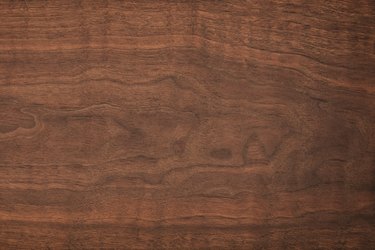
Rubbing alcohol and finished wood don't mix well. A rubbing alcohol spill on your wood furniture can be disastrous, as they are often permanent stains. That's why taking care of the stain promptly and properly is critical. Fixing a rubbing alcohol stain on a tabletop is possible, but you'll need to do it quickly.
Clean Up the Spill
Video of the Day
The first thing to do is immediately absorb any excess alcohol from the tabletop's surface. As soon as it spills, use whatever is handy nearby to mop up the rubbing alcohol or isopropyl alcohol. Ideally, use a clean white rag, but you can also use whatever is handy nearby, including napkins, paper towels, a blanket or clothing. Most cotton and polyester clothes will be fine if they come in contact with rubbing alcohol but your wood furniture will not.
Video of the Day
Take the rag and absorb the excess alcohol without rubbing or scrubbing. Doing so could spread the alcohol and cause more damage to the surface of the wood. You need to act quickly because alcohol stains absorb into wood quickly. The longer they sit, the deeper they penetrate and the further they spread. A small splash can become a big mess if it's not cleaned immediately.
In the future, always lay down a towel, use a tablecloth or otherwise cover a wood surface if you're using alcohol on it. This layer can prevent a great deal of damage and prolong the life of your furniture.
Treat the Tabletop With Oil
Now that you've cleaned up all of the excess alcohol, you can treat the stain to restore the table to its aged appearance and get rid of any evidence of a spill. You may be able to get away with buffing out the stain using just furniture oil. Take another clean rag and moisten it with furniture oil. Rub the stain in the direction of the grain of the wood, adding more oil to match the color of the wood if needed. You will know pretty quickly if the stain appears to be fading; if it's not, proceed to use linseed oil and rottenstone.
Combine equal amounts of boiled linseed oil with rottenstone to create a paste. You can buy both materials at most hardware or paint supply stores. Take a soft cloth and gently rub the mixture onto the stain. Rub only in the direction of the grain of the wood. Rottenstone is a mild abrasive, so you shouldn't have to use much pressure. Use the clean part of the rag to wipe off any remaining linseed oil and rottenstone once the stain is gone.
Finish Treating the Stain
It's more than possible that the spot where the stain was located looks a little worn, even if you've taken care of the alcohol stain itself. If that's the case, one possible option to make it less noticeable is to use furniture wax to polish it. You can even take this opportunity to wax and clean the entire table, restoring its new look and sheen.
In addition, keep in mind that you should re-stain wood tabletops every one to two years even if they are treated by the manufacturer. This re-staining should prevent any spills from absorbing into the wood. Even if it doesn't entirely prevent the spill, it can make sure that the stain is not as noticeable. Choose an appropriate polyurethane or another type of lacquer. Complete this task outside, in the garage or in a well-ventilated part of your home since the fumes can be dangerous. Allow them to dry completely before use.